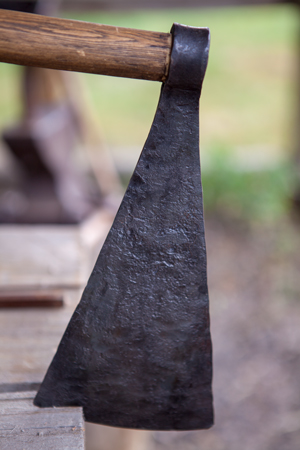19th-century war axe

Photo © 2013 Kris Townsend
On their return trip, the Lewis and Clark expedition camped on the North side of the Clearwater River, near Fir Island at mile post 21, on Highway 12.
On May 6, 1806, Sergt. Ordway wrote in his journal:
several of the natives gambled in the same way as those below had buff aloe robes war axes & C. staked up the war axes these Indians have they got from the Grousevountares on the Missourie & they got them from us at the Mandans.
Ordway was the only journalist that recorded seeing the war axes and implies that he was told the Chopunnish (Nez Perce) Indians got them from the Hidatsa Indians the previous year. If the Nez Perce did get the axes from the Hidatsas, they were in the Clearwater valley when Lewis and Clark passed through the region in 1805.
Did the Lewis and Clark party actually get information from the natives that they in fact did bring these war axes from the Great Plains in 1805, or did the expedition carry these axes from Fort Mandan and use them for trade items with the Nez Perce on the Clearwater River in 1805?
None of the journalists ever recorded carrying any war axes they made at Fort Mandan for trade items, however on August 24, 1805, when Lewis was camped with the Shoshone Indians at Camp Fortunate, near Dillon, Montana, he wrote:
As the Indians who were on their way down the Missouri had a number of spare hoses with them I thought it probable that I could obtain some of them and therefore desired the Cheif to speak to them and inform me whether they would trade. they gave no positive answer but requested to see the goods which I was willing to give in exchange. I now produced some battle axes which I had made at Fort Mandan with which they were much pleased. knives also seemed a great demand among them. I soon purchased three horses and a mule. for each horse I gave an ax a knife handkercheif and a little paint; & for the mule the addition of a knife a shirt handkercheif and a pair of legings . . . .
This was the only time any of the journalists recorded using war axes for trading purposes after they left the Fort Mandan. It is possible that they carried some more of these war axes for trade items.
On May 11, 1806, Lewis and Clark were camped with Chief Broken Arm, near the mouth of Suzie Creek, about four miles up Lawyers Creek from Kamiah, Idaho. They held a council with the Indians. They used a Shoshone boy, they first encountered on May 5, to interpret for them. The interpretation had to pass through five different languages, Choppunish, (Nez Perce) Shoshone, Hidatsa, French to English. This made the council very tedious and not very accurate. After the council Lewis wrote:
after this Council was over we amused ourselves with Shewing them the power of Magnetism, the Spye glass, compass, watch, air gun and Sundery other articles equally novel and incomprehensible to them. they informed us that after we left the Menetares last Spring that 3 of their people had visited that nation, and that they had informed them of us, and had told them that we had Such things in our possession but that they Could not place Confidence in the information untill they had now witnessed it themselves—.
Did these three men, or other men of the Chopunnish nation obtain the war axes from the Hidatsa and bring them to the Clearwater valley in !805? If Lewis and Clark would have used war axes for trade items with the Nez Perce in 1805, Ordway should have known and would have recorded it. I think it is fair to assume the Chopunnish or Nez Perce brought the war axes to the Clearwater valley.
Information from the Journals of Lewis & Clark Expedition, Gary E. Moulton, Editor, University of Nebraska Press.